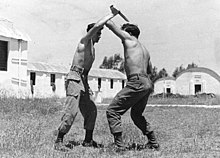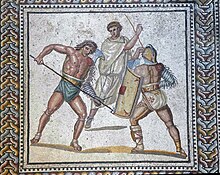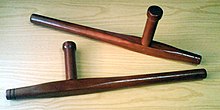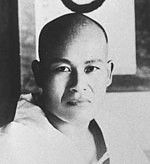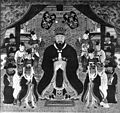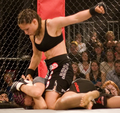Portal:Martial arts
The Martial Arts Portal

Martial arts are codified systems and traditions of combat practiced for a number of reasons such as self-defence; military and law enforcement applications; competition; physical, mental, and spiritual development; entertainment; and the preservation of a nation's intangible cultural heritage. (Full article...)
Although the earliest evidence of martial arts goes back millennia, the true roots are difficult to reconstruct. Inherent patterns of human aggression which inspire practice of mock combat (in particular wrestling) and optimization of serious close combat as cultural universals are doubtlessly inherited from the pre-human stage and were made into an "art" from the earliest emergence of that concept. Indeed, many universals of martial art are fixed by the specifics of human physiology and not dependent on a specific tradition or era.
Specific martial traditions become identifiable in Classical Antiquity, with disciplines such as shuai jiao, Greek wrestling or those described in the Indian epics or the Spring and Autumn Annals of China. (Full article...)
Selected articles
Selected biography
The son of a landowner from Tanabe, Ueshiba studied a number of martial arts in his youth, and served in the Japanese Army during the Russo-Japanese War. After being discharged in 1907, he moved to Hokkaidō as the head of a pioneer settlement; here he met and studied with Takeda Sōkaku, the headmaster of Daitō-ryū Aiki-jūjutsu. On leaving Hokkaido in 1919, Ueshiba joined the Ōmoto-kyō movement, a Shinto sect, in Ayabe, where he served as a martial arts instructor and opened his first dojo. He accompanied the head of the Ōmoto-kyō group, Onisaburo Deguchi, on an expedition to Mongolia in 1924, where they were captured by Chinese troops and returned to Japan. The following year, he had a profound spiritual experience, stating that, "a golden spirit sprang up from the ground, veiled my body, and changed my body into a golden one." After this experience, his martial arts technique became gentler, with a greater emphasis on the control of ki.
Ueshiba moved to Tokyo in 1926, where he set up what would become the Aikikai Hombu Dojo. By now he was comparatively famous in martial arts circles, and taught at this dojo and others around Japan, including in several military academies. In the aftermath of World War II the Hombu dojo was temporarily closed, but Ueshiba had by this point left Tokyo and retired to Iwama, and he continued training at the dojo he had set up there. From the end of the war until the 1960s, he worked to promote aikido throughout Japan and abroad. He died from liver cancer in 1969.
After Ueshiba's death, aikido continued to be promulgated by his students (many of whom became noted martial artists in their own right). It is now practiced around the world. (Full article...)
Selected entertainment
Girlfight is a 2000 American sports drama film written and directed by Karyn Kusama in her feature directorial debut, and stars Michelle Rodriguez in her first film role. The film follows Diana Guzman, a troubled Brooklyn high school student who decides to channel her aggression by training to become a boxer, despite the disapproval of both her father and her prospective trainers, as well as the competitors in the male-dominated sport.
Kusama wrote the screenplay for Girlfight after learning to box, wanting to make a film about the sport with a female protagonist. Although she struggled to find financiers for the film's $1 million budget, the production was eventually funded by John Sayles, Maggie Renzi and the Independent Film Channel. Rodriguez was cast in the lead role despite having never acted before, and trained in boxing for four months before filming commenced in New York and New Jersey.
Girlfight premiered at the Sundance Film Festival on January 22, 2000, where it tied with You Can Count on Me for the Grand Jury Prize, and Kusama won the Best Director Award. It was theatrically released on September 29, 2000, to critical acclaim, with particular praise for Rodriguez's performance and Kusama's direction. The film earned several accolades, including a nomination for the Bronze Horse at the 2000 Stockholm International Film Festival. At the 16th Independent Spirit Awards, Kusama was nominated for Best First Feature and Rodriguez won for Best Debut Performance.
Sports portals
Selected image
 |
Wrestlers is a name shared by three closely related 1899 paintings by American artist Thomas Eakins, (Goodrich catalog #317, #318, #319). The Los Angeles County Museum of Art (LACMA) owns the finished painting (G-317), and the oil sketch (G-318). The Philadelphia Museum of Art (PMA) owns a slightly smaller unfinished version (G-319). All three works depict a pair of nearly naked men engaged in a wrestling match. The setting for the finished painting is the Quaker City Barge Club (defunct), which once stood on Philadelphia's Boathouse Row. (Full article...)
General images -
Selected quote
Topics
- Regional origin - China - Europe - India - Indonesia - Japan - Korea - Philippines
- Unarmed techniques - Chokehold - Clinch - Footwork - Elbow strike - Headbutt - Hold - Kick - Knee strike - Joint lock - Punch - Sweep - Takedown - Throw
- Weapons - Archery - Duel - Knife fighting - Melee weapons - Shooting - Stick-fighting - Swordsmanship
- Training - Kata - Practice weapon - Punching bag - Pushing hands - Randori - Sparring
- Striking - Boxing - Capoeira - Karate - Kickboxing - Muay Thai - Lethwei - Sanshou - Savate - Taekwondo - Vovinam
- Internal - Aikido - Aikijutsu - Baguazhang - Tai chi - Xing Yi Quan
- Full contact / Combat sports - Professional boxing - Professional kickboxing - Knockdown karate - Mixed martial arts - Pankration - Submission wrestling
- Self-defense / Combatives - Arnis - Bartitsu - Hapkido - Kajukenbo - Krav Maga - MCMAP - Pencak Silat - Systema - Wing Chun - Legal aspects
- Eclectic / Hybrids - American Kenpo - Chun Kuk Do - Jeet Kune Do - Shooto - Shorinji Kempo - Unifight
Categories
Things you can do
See the list on the right of Martial art related projects who organise work on these articles. You can also add your self to the list of Wikipedians by martial art
Talk page tagging
If you come across a martial arts related article, adding the project template {{WikiProject Martial arts}} to the talk page will help identify them for improvement and linking to related articles. For Boxing, Fencing, Mixed martial arts and Sumo. Use {{WikiProject Boxing}}, {{WikiProject Fencing}}, {{WikiProject Mixed martial arts}} and {{WikiProject Sumo}} respectively.
- Assessment
- If possible please assess articles you tag using guidelines (Boxing, Mixed martial arts and Sumo).
Deletions
Monitor and contribute to deletion debates (Boxing).
Find images
Wikipedia requested images of martial artists, mixed martial artists and boxers.
Associated Wikimedia
The following Wikimedia Foundation sister projects provide more on this subject:
-
Commons
Free media repository -
Wikibooks
Free textbooks and manuals -
Wikidata
Free knowledge base -
Wikinews
Free-content news -
Wikiquote
Collection of quotations -
Wikisource
Free-content library -
Wikiversity
Free learning tools -
Wikivoyage
Free travel guide -
Wiktionary
Dictionary and thesaurus




